Civil Rights Movement Timeline
The civil rights movement emerges less than 100 years after slavery has been abolished in 1865. It grows in response to the racial attitudes and segregation that remain within society.
1948
|
July 26, 1948: Truman's Executive Order 9981
President Truman signs Executive Order 9981, which states, "It is hereby declared to be the policy of the President that there shall be equality of treatment and opportunity for all persons in the armed services without regard to race, color, religion, or national origin."
|
|---|
1954
|
May 17, 1954: Brown v. Board of Education of Topeka, Kansas Ruling
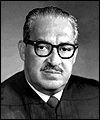 The Supreme Court rules on the landmark case Brown v. Board of Education of Topeka, Kans., unanimously agreeing that segregation in public schools is unconstitutional. The ruling paves the way for large-scale desegregation. The decision overturned the 1896 Plessy v. Ferguson ruling that sanctioned "separate but equal" segregation of the races, ruling that "separate educational facilities are inherently unequal." It is a victory for NAACP attorney Thurgood Marshall, who will later return to the Supreme Court as the nation's first Black justice. The Supreme Court rules on the landmark case Brown v. Board of Education of Topeka, Kans., unanimously agreeing that segregation in public schools is unconstitutional. The ruling paves the way for large-scale desegregation. The decision overturned the 1896 Plessy v. Ferguson ruling that sanctioned "separate but equal" segregation of the races, ruling that "separate educational facilities are inherently unequal." It is a victory for NAACP attorney Thurgood Marshall, who will later return to the Supreme Court as the nation's first Black justice.
|
|---|
1955
|
August 28, 1955: Emmett Till's Murder
Fourteen-year-old Chicagoan Emmett Till is visiting family in Mississippi when he is kidnapped, brutally beaten, shot, and dumped in the Tallahatchie River for allegedly whistling at a white woman. Two white men, J. W. Milam and Roy Bryant, are arrested for the murder and acquitted by an all-white jury. They later boast about committing the murder in a Look magazine interview. The case becomes a cause célèbre of the civil rights movement.
December 1, 1955: Rosa Parks Defies Bus Customs
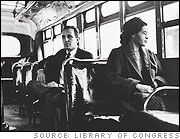 Rosa Parks (Montgomery, Ala.) NAACP member Rosa Parks refuses to give up her seat at the front of the "colored section" of a bus to a white passenger, defying a southern custom of the time. In response to her arrest, the Montgomery Black community launches a bus boycott, which will last for more than a year, until the buses are desegregated Dec. 21, 1956. As the newly elected president of the Montgomery Improvement Association (MIA), Reverend Martin Luther King, Jr., is instrumental in leading the boycott. Rosa Parks (Montgomery, Ala.) NAACP member Rosa Parks refuses to give up her seat at the front of the "colored section" of a bus to a white passenger, defying a southern custom of the time. In response to her arrest, the Montgomery Black community launches a bus boycott, which will last for more than a year, until the buses are desegregated Dec. 21, 1956. As the newly elected president of the Montgomery Improvement Association (MIA), Reverend Martin Luther King, Jr., is instrumental in leading the boycott.
|
|---|
1957
|
January—February 1957: MLK's Southern Christian Leadership Conference
Martin Luther King, Charles K. Steele, and Fred L. Shuttlesworth establish the Southern Christian Leadership Conference, of which King is made the first president. The SCLC becomes a major force in organizing the civil rights movement and bases its principles on nonviolence and civil disobedience. According to King, it is essential that the civil rights movement not sink to the level of the racists and hatemongers who oppose them: "We must forever conduct our struggle on the high plane of dignity and discipline," he urges.
September 1957: The Little Rock Nine
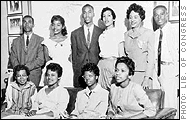 Formerly all-white Central High School learns that integration is easier said than done, at Little Rock, Arkansas. Nine Black students are blocked from entering the school on the orders of Governor Orval Faubus. President Eisenhower sends federal troops and the National Guard to intervene on behalf of the students, who become known as the "Little Rock Nine." The plight of these nine individuals draws national attention with all nine of the African-American students being admitted into the school by the end of September.
|
|---|
1960
|
February 1, 1960: The Greensboro Sit-In
(Greensboro, N.C.) Four Black students from North Carolina Agricultural and Technical College begin a sit-in at a segregated Woolworth's lunch counter. Although they are refused service, they are allowed to stay at the counter. The event triggers many similar nonviolent protests throughout the South. Six months later the original four protesters are served lunch at the same Woolworth's counter. Student sit-ins would be effective throughout the Deep South in integrating parks, swimming pools, theaters, libraries, and other public facilities.
April 1960: Student Nonviolent Coordinating Committee Established
(Raleigh, N.C.) The Student Nonviolent Coordinating Committee (SNCC) is founded at Shaw University, providing young Black people with a place in the civil rights movement. The SNCC later grows into a more radical organization, especially under the leadership of Stokely Carmichael (1966–1967).
|
|---|
1961
|
May 4, 1961: The Freedom Riders
Over the spring and summer, student volunteers begin taking bus trips through the South to test out new laws that prohibit segregation in interstate travel facilities, which include bus and railway stations. Several of the groups of "freedom riders," as they are called, are attacked by angry mobs along the way. The program, sponsored by The Congress of Racial Equality (CORE) and the Student Nonviolent Coordinating Committee (SNCC), involves more than 1,000 volunteers, both Black and white individuals. Freedom rides often result in police arrests and violent protests but help to highlight the issue of segregation.
|
|---|
1962
|
October 1, 1962: Ole Miss' First Black Student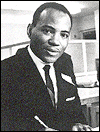
James Meredith becomes the first Black student to enroll at the University of Mississippi. Violence and riots surrounding the incident caused President Kennedy to send 5,000 federal troops. Meredith reported experiencing continual harassment during his time at the university but graduated with a degree in political science.
|
|---|
1963
|
April 16, 1963: MLK Jr. Jailed
Martin Luther King Jr. is arrested and jailed during anti-segregation protests in Birmingham, Ala.; he writes his seminal "Letter from Birmingham Jail," arguing that individuals have the moral duty to disobey unjust laws. It emphasizes his belief in non-violence while urging religious people to break loose from the "paralyzing chains of conformity".
May 3, 1963: Televised Brutality to Spark Reform
During civil rights protests in Birmingham, Alabama, Commissioner of Public Safety Eugene "Bull" Connor uses fire hoses and police dogs on Black demonstrators. These images of brutality, which are televised and published widely, are instrumental in gaining sympathy for the civil rights movement around the world.
June 12, 1963: Medgar Evers Murdered
(Jackson, Miss.) Mississippi's NAACP field secretary, 37-year-old Medgar Evers, is murdered outside his home. Byron De La Beckwith is tried twice in 1964, both trials resulting in hung juries. Thirty years later he is convicted of murdering Evers.
August 28, 1963: The March on Washington & "I Have a Dream"
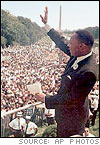 (Washington, D.C.) About 200,000 people join the March on Washington. Congregating at the Lincoln Memorial, participants listen as Martin Luther King delivers his famous "I Have a Dream" speech. The impact of the speech is seen as being a major factor in the passing for the Civil Rights Act of 1964. (Washington, D.C.) About 200,000 people join the March on Washington. Congregating at the Lincoln Memorial, participants listen as Martin Luther King delivers his famous "I Have a Dream" speech. The impact of the speech is seen as being a major factor in the passing for the Civil Rights Act of 1964.
September 15, 1963: Fatal Sixteenth Street Baptist Church Bombing
(Birmingham, Ala.) Four young girls (Denise McNair, Cynthia Wesley, Carole Robertson, and Addie Mae Collins) attending Sunday school are killed when a bomb explodes at the Sixteenth Street Baptist Church, a popular location for civil rights meetings. Riots erupt in Birmingham, leading to the deaths of two more Black youths.
|
|---|
1964
|
January 23, 1964: Poll Tax Is Scrapped
The 24th Amendment abolishes the poll tax, which originally had been instituted in 11 southern states after Reconstruction to make it difficult for poor Black people to vote. The poll tax was a fee required by states before a person became eligible to vote in a national election. Scrapping the poll tax, President Lyndon B. Johnson said, “There can be no one too poor to vote.”
Summer 1964: Freedom Summer for Black Voters
The Council of Federated Organizations (COFO), a network of civil rights groups that includes CORE and SNCC, launches a massive effort to register Black voters during what becomes known as the Freedom Summer. It also sends delegates to the Democratic National Convention to protest—and attempt to unseat—the official all-white Mississippi contingent.
July 2, 1964: Johnson's Civil Rights Act
President Johnson signs the Civil Rights Act of 1964. The legislation is originally presented by John F. Kennedy before his assassination in 1963. The most sweeping civil rights legislation since Reconstruction, the Civil Rights Act prohibits discrimination of all kinds based on race, color, religion, or national origin. The law also provides the federal government with the power to enforce desegregation.
August 4, 1964: KKK Murders in Mississippi
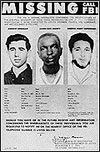
(Neshoba Country, Miss.) The bodies of three civil-rights workers—two white, one Black—are found in an earthen dam, six weeks into a federal investigation backed by President Johnson. James E. Chaney, 21; Andrew Goodman, 21; and Michael Schwerner, 24, had been working to register Black voters in Mississippi, and, on June 21, had gone to investigate the burning of a black church. They were arrested by the police on speeding charges, incarcerated for several hours, and then released after dark into the hands of the Ku Klux Klan, who murdered them.
|
|---|
1965
|
February 21, 1965: Malcolm X Murdered
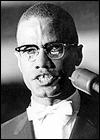
(Harlem, N.Y.) Malcolm X, Black nationalist and founder of the Organization of Afro-American Unity, is shot to death. It is believed the assailants are members of the Black Muslim faith, which Malcolm had recently abandoned in favor of orthodox Islam.
March 7, 1965: Bloody Sunday Brutality
(Selma, Ala.) Black people begin a march to Montgomery in support of voting rights but are stopped at the Pettus Bridge by a police blockade. Fifty marchers are hospitalized after police use tear gas, whips, and clubs against them. The incident is dubbed "Bloody Sunday" by the media. The march is considered the catalyst for pushing through the voting rights act five months later.
August 10, 1965: Congress' Voting Rights Act Passes
Congress passes the Voting Rights Act of 1965, making it easier for Southern Black people to register to vote. Literacy tests, poll taxes, and other such requirements that were used to restrict Black voting are made illegal.
August 11—17, 1965: Los Angeles Riots
(Watts, Calif.) Race riots erupt in a Black section of Los Angeles.
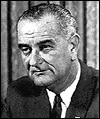
September 24, 1965: Johnson's Executive Order 11246
Asserting that civil rights laws alone are not enough to remedy discrimination, President Johnson issues Executive Order 11246, which enforces affirmative action for the first time. It requires government contractors to "take affirmative action" toward prospective minority employees in all aspects of hiring and employment.
|
|---|
1966
|
October 1966: Establishing the Black Panthers
(Oakland, Calif.) The militant Black Panthers are founded by Huey Newton and Bobby Seale.The group has revolutionary aims with an ideology of Black nationalism, socialism, and armed resistance to police brutality. It formed a part of a radical movement that rejects the non-violence policies of mainstream civil rights organizations.
|
|---|
1967
|
April 19, 1967: "Black Power" Begins
Stokely Carmichael, a leader of the Student Nonviolent Coordinating Committee (SNCC), coins the phrase "Black power" in a speech in Seattle. He defines it as an assertion of Black pride and "the coming together of Black people to fight for their liberation by any means necessary." The term's radicalism alarms many who believe the civil rights movement's effectiveness and moral authority crucially depend on nonviolent civil disobedience.
June 12, 1967: Loving v. Virginia Rules for Interracial Marriage
In Loving v. Virginia, the Supreme Court rules that prohibiting interracial marriage is unconstitutional. Sixteen states that still banned interracial marriage at the time are forced to revise their laws.
July 1967: Race Riots Continue
Major race riots take place in Newark (July 12–16) and Detroit (July 23–30). They are among the many flare-ups that occur in cities across America during the summer of 1967, resulting in around 80 deaths and 17,000 arrests. In the majority of disturbances, confrontations occur between Black protesters and white police officers.
|
|---|
1968
|
April 4, 1968: MLK Murdered in Memphis
(Memphis, Tenn.) Martin Luther King Jr., at age 39, is shot as he stands on the balcony outside his hotel room. Escaped convict and committed racist James Earl Ray is convicted of the crime. The death sparks a series of protests and outbreaks of violence in American cities. James Earl Ray died in prison on April 23, 1998.
April 11, 1968: Johnson's Fair Housing Act.
President Johnson signs the Civil Rights Act of 1968, prohibiting discrimination in the sale, rental, and financing of housing. Also referred to as the Fair Housing Act, the legislation was passed in the wake of the assassination of civil rights leader Martin Luther Jr.
|
|---|
1971
|
April 20, 1971: Swann v. Charlotte-Mecklenburg Board of Education Rules for Integration
The Supreme Court, in Swann v. Charlotte-Mecklenburg Board of Education, upholds busing as a legitimate means for achieving integration of public schools. Although largely unwelcome (and sometimes violently opposed) in local school districts, court-ordered busing plans in cities such as Charlotte, Boston, and Denver continue until the late 1990s.
|
|---|
1988
|
March 22, 1988: Civil Rights Restoration Act for Non-Discrimination
Overriding President Reagan's veto, Congress passes the Civil Rights Restoration Act, which expands the reach of non-discrimination laws within private institutions receiving federal funds.
|
|---|
1991
|
November 22, 1991: Bush's Reversal, Signs Civil Rights Act
After two years of debates, vetoes, and threatened vetoes, President Bush reverses himself and signs the Civil Rights Act of 1991, strengthening existing civil rights laws and providing for damages in cases of intentional employment discrimination.
|
|---|
1992
|
April 29, 1992: Rodney King's Assaulters' Acquitted, Riots Ensue
(Los Angeles, Calif.) The first race riots in decades erupt in south-central Los Angeles after a jury acquits four white police officers for the videotaped beating of African American Rodney King. The riots left 63 people dead, 12,000 arrests, and estimated property damage in excess of $1 billion.
|
|---|
2003
|
June 23, 2003: Race in University Considerations
In the most important affirmative action decision since the 1978 Bakke case, the Supreme Court (5-4) upholds the University of Michigan Law School's policy, ruling that race can be one of many factors considered by colleges when selecting their students because it furthers "a compelling interest in obtaining the educational benefits that flow from a diverse student body."
(See also: Affirmative Action Timeline.)
|
|---|
2005
|
June 21, 2005: Killer Edgar Ray Killen Convicted
The ringleader of the Mississippi civil rights murders (see Aug. 4, 1964), Edgar Ray Killen, is convicted of manslaughter on the 41st anniversary of the crimes.
October 24, 2005: Rosa Parks Passes Away
Rosa Parks dies at age 92. Her pivotal role in the Montgomery bus boycott made her an international icon of resistance to racial segregation. But it also led to her losing her job as a department store seamstress. She later moved to Detroit where she worked for African-American US Representative John Conyers. After retiring, Parks wrote her biography “Rosa Parks: My Story”, which is published in 1992.
|
|---|
2006
|
January 30, 2006: MLK's Wife Dies
Coretta Scott King dies of a stroke at age 78. An author and civil rights activist who was married to Martin Luther King Jr. After her husband’s assassination, she continues to campaign for racial equality and led a successful campaign to turn the date of her husband’s death, November 2, into a national holiday. Her funeral is attended by more than 10,000 people.
|
|---|
2007
|
February 2007: Emmett Till Case Reopened, Offenders Already Dead
Emmett Till's 1955 murder case, reopened by the Department of Justice in 2004, is officially closed. The two confessed murderers, J. W. Milam and Roy Bryant, were dead of cancer by 1994, and prosecutors lacked sufficient evidence to pursue further convictions.
May 10, 2007: Jimmie Lee Jackson's Killer Sentenced
James Bonard Fowler, a former state trooper, is indicted for the murder of Jimmie Lee Jackson 42 years after Jackson's death. Aged 77, Fowler pleaded guilty to one count of second-degree manslaughter and was sentenced to six months in prison. The 1965 killing lead to a series of historic civil rights protests in Selma, Alabama.
|
|---|
2008
|
January 2008: Bill Against Employer Discrimination
Senator Edward Kennedy (D-MA) introduces the Civil Rights Act of 2008. Some of the proposed provisions include ensuring that federal funds are not used to subsidize discrimination, holding employers accountable for age discrimination, and improving accountability for other violations of civil rights and workers' rights.
|
|---|
2013
|
June 2013: Better Black Voting Rights
In Shelby County v. Holder, the Supreme Court struck down Section 4 of the Voting Rights Act, which established a formula for Congress to use when determining if a state or voting jurisdiction requires prior approval before changing its voting laws. Under Section 5 of the act, nine—mostly Southern—states with a history of discrimination must get clearance from Congress before changing voting rules to make sure racial minorities are not negatively affected. While the 5–4 decision did not invalidate Section 5, it made it toothless.
Chief Justice John Roberts said the formula Congress now uses, which was written in 1965, has become outdated. "While any racial discrimination in voting is too much, Congress must ensure that the legislation it passes to remedy that problem speaks to current conditions," he said in the majority opinion. In a strongly worded dissent, Judge Ruth Bader Ginsburg said, "Hubris is a fit word for today's demolition of the V.R.A." (Voting Rights Act).
July 2013: The Birth of Black Lives Matter
A Black Lives Matter movement emerges after George Zimmerman is acquitted of the shooting of African-American teenager Trayvon Martin in February 2012. The "BlackLivesMatter" phrase is used as a hashtag on social media to express anger at the treatment of African-Americans by the justice system.
The phrase became established as it's used in the wake of similar cases such as the deaths of Michael Brown, Eric Garner, and Pamela Turner.
Later, in 2014, three activists, Alicia Garza, Patrisse Cullors, and Opal Tometi, form Black Lives Matter into a civil rights organization with a focus on police brutality and racism. It has since become a global social movement with a wider focus on human rights.
|
|---|
2020
|
May 25, 2020: George Floyd Murdered, Black Lives Matter Protests
Police in Minneapolis arrested 46-year-old African American, George Floyd after he was alleged to have paid for cigarettes with a counterfeit $20 bill. Mr. Floyd dies during the arrest as three police officers pin him down with a knee pressed against his neck.
Videos of the encounter that circulated the following day caused an angry response with a protest march and confrontations between demonstrators and the police. The situation escalates over the following nights with protests and outbreaks of rioting and arson.
The unrest spreads to cities across the United States as the issue becomes a focal point for Black Lives Matters demonstrations. While most of the protests are peaceful, the police make more than 14,000 arrests in 49 different cities.
Derek Chauvin, a police officer involved in the arrest of George Floyd, was sentenced to 22 years in prison after being found guilty of his murder.
|
|---|
|

















